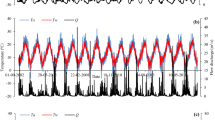Abstract
Water temperature directly affects the physical, biological and chemical characteristics of the river and determines the fitness and life of all aquatic organisms. It has direct and indirect effects on nearly all aspects of stream ecology. Accurately estimating water temperature is a complex problem. The purpose of this article is to analyze the relationship between the air and water temperature of the River Drava by constructing an artificial neural network (ANN) model and choosing appropriate network architectures for the River Drava’s daily river water temperature as well as demonstrating its application in improving the interpretation of the results. A linear regression model, as well as a stochastic model are also constructed and compared to ANN models consisting of a multilayer perceptron neural network and a radial basis function network. The results indicate that the ANN models are much better models and that ANNs are powerful tools that can be used for the estimation of daily mean river temperature.






Similar content being viewed by others
References
Agarwal A, Singh RD (2004) Runoff modelling through back propagation artificial neural network with variable rainfall-runoff data. Water Resour Res 18:285–300
Awchi TA (2014) River discharges forecasting in northern Iraq using different ANN techniques. Water Resour Res. doi:10.1007/s11269-014-0516-3
Benyahya L, Caissie D, St-Hilaire A, Ouarda TBMJ, Bobée B (2007) A review of statistical water temperature models. Can Water Resour J 32(3):179–192
Bhadra A, Bandyopadhyay A, Singh R, Raghuwanshi NS (2010) Rainfall-runoff modeling: comparison of two approaches with different data requirements. Water Resour Res 24:37–62
Bishop C (2006) Pattern recognition and machine learning. Springer, Secaucus
Caissie D (2006) The thermal regime of rivers-a review. Freshw Biol 51:1389–1406
Chen S, Cowan CFN, Grant PM (1991) Orthogonal least squares learning algorithm for radial basis function networks. IEEE Trans Neural Netw 2(2):302–309
Chen YW, Chang LC, Huang CW, Chu HJ (2013) Applying genetic algorithm and neural network to the conjunctive use of surface and subsurface water. Water Resour Res 27:4731–4757
Chenard JF, Caissie D (2008) Stream temperature modelling using artificial neural networks: application on Catamaran Brook, New Brunswick, Canada. Hydrol Process 22(17):3361–3372
Cluis DA (1972) Relationship between stream water temperature and ambient air temperature—a simple autoregressive model for mean daily stream water temperature fluctuations. Nord Hydrol 3:65–71
El-Shafie A, Najah A, Alsulami HM, Jahanbani H (2014) Optimized neural network prediction model for potential evapotranspiration utilizing ensemble procedure. Water Resour Res. doi:10.1007/s11269-014-0526-1
Gopakumar R, Kaoru, James EJ (2007) Hydrologic data exploration and river flow forecasting of a humid tropical river basin using artificial neural networks. Water Resour Res 21:1915–1940
Haykin S (1999) Neural networks: A comprehensive foundation, 2nd edn. Prentice Hall, Upper Saddle River
Iglesias C, Torres JM, Nieto PJG, Fernández JRA, Muñiz CD, Piñeiro JI, Taboada J (2014) Turbidity prediction in a river basin by using artificial neural networks: a case study in northern Spain. Water Resour Res 28:319–331
Kakahaji H, Banadaki HD, Kakahaji A, Kakahaji A (2013) Prediction of Urmia Lake water-level fluctuations by using analytical, linear statistic and intelligent methods. Water Resour Res 27:4469–4492. doi:10.1007/s11269-013-0420-2
Kothandaraman V (1971) Analysis of water temperature variations in large rivers. J Sanit Eng Div 97:19–31
Legates DR, McCabe GJ (1999) Evaluating the use of goodnessof- fit measures in hydrologic and hydroclimatic model validation. Water Resour Res 35(1):233–241
Levenberg K (1944) A method for the solution of certain non-linear problems in least squares. Q Appl Math 2:164–168
Moustris KP, Larissi IK, Nastos PT, Paliatsos AG (2011) Precipitation forecast using artificial neural networks in specific regions of Greece. Water Resour Res 25:1979–1993. doi:10.1007/s11269-011-9790-5
Nash JE, Sutcliffe JV (1970) River flow forecasting through conceptual models. Part A. Discussion of principles. J Hydrol 10:282–290
Rahimikhoob A (2014) Comparison between M5 model tree and neural networks for estimating reference evapotranspiration in an arid environment. Water Resour Res. doi:10.1007/s11269-013-0506-x
Rumelhart DE, Hinton GE, Williams RJ (1986) Learning representations by back-propagating errors. Nature 323(6088):533–536
Sahoo GB, Schladow SG, Reuter JE (2009) Forecasting stream water temperature using regression analysis, artificial neural network, and chaotic non-linear dynamic models. J Hydrol 378:325–342
Singh KK, Pal M, Singh VP (2010) Estimation of mean annual flood in Indian catchments using backpropagation neural network and M5 model tree. Water Resour Res 24(10):2007–2019
Sivri N, Ozcan HK, Ucan ON, Akincilar O (2009) Estimation of stream temperature in Degirmendere River (Trabzon-Turkey) using artificial neural network model. Turk J Fish Aquat Sci 9:145–150
Webb BW, Nobilis F (1997) A long-term perspective on the nature of the air-water temperature relationship: a case study. Hydrol Process 11:137–147
Yang XS (2009) Firefly algorithms for multimodal optimization. Stochastic Algorithms: Foundations and Applications, 5th International Symposium SAGA 2009, 169–178
Acknowledgments
The authors would like to thank the Croatian Meteorological and Hydrological Service (DHMZ) for providing the required meteorological data.
Author information
Authors and Affiliations
Corresponding author
Rights and permissions
About this article
Cite this article
Hadzima-Nyarko, M., Rabi, A. & Šperac, M. Implementation of Artificial Neural Networks in Modeling the Water-Air Temperature Relationship of the River Drava. Water Resour Manage 28, 1379–1394 (2014). https://doi.org/10.1007/s11269-014-0557-7
Received:
Accepted:
Published:
Issue Date:
DOI: https://doi.org/10.1007/s11269-014-0557-7




